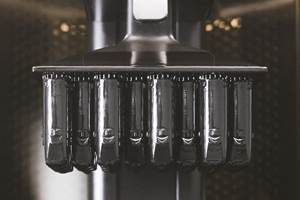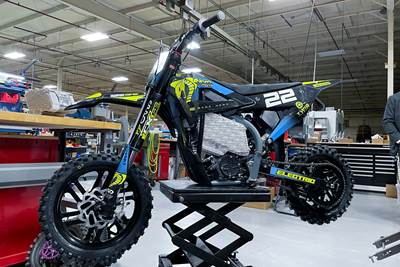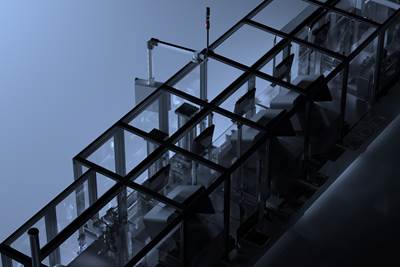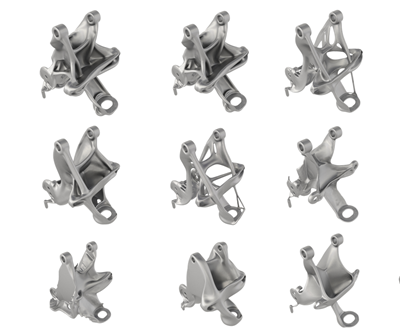
Conventional battery electrodes are made through processes requiring tooling. The ability to 3D print these electrodes opens new cell and pack geometries, as well as better energy density and performance. Photo Credits: Photocentric
The future of transportation is electric vehicles (EVs), and the heart of an EV is the battery. Yet the options for improving battery performance are limited with the methods currently used to make them.
How limited? Battery electrodes are commonly made by slip casting a slurry of active material into a sheet, punching out pouch or coin cells, and then arranging those cells to fit inside a rectangular or cylindrical casing. Creating a more powerful battery with this method entails building thicker electrodes — which can result in problematic cracking — and larger cells by stacking the electrodes on top of one another. The pursuit of better performance thus can lead to heavier, bulkier battery packs that don’t provide optimal efficiency or range for a given product.

Sarah Karmel, head of chemistry for Photocentric when this story was first published in 2021.
“There is no flexibility in the battery design,” says Sarah Karmel, head of chemistry for Photocentric, which is working on a solution. The UK-based provider of stereolithography-style 3D printers is currently exploring the promise of 3D printing electrodes for EVs and other battery-powered products such as drones. Additively manufactured electrodes that can be made in any shape and configuration could open the door to EVs that are faster to charge and lighter weight, translating to better range — and helping to overcome what have thus far been limiting factors for these vehicles.
3D Printing for Optimized Battery Electrode Architecture
Additive manufacturing (AM) has brought geometric freedom to other industries and applications; think a jet fuel nozzle that is now just one part instead of twenty, or a structural component for an electric car that is half the weight of its conventionally shaped and welded predecessor. The ability to 3D print batteries will bring geometric freedom as well, allowing cells and packs to be designed to fit the product, rather than forcing the product to accommodate a conventional battery pack. This is a significant change that could bring new freedoms to EV design. But this is just the start.
The flexibility Karmel sees for EV batteries is not limited to the overall shape of the cell or battery pack. There are additional design opportunities to be found within the electrodes themselves, the anodes and cathodes that together form battery cells. By working with a simulation partner, Photocentric is learning to design and 3D print optimized electrode architectures not previously possible.

Conventional battery electrode architectures (left) limit the possible configurations of the anode and cathode. A 3D printed architecture (right) allows for innovative designs like intercalated electrodes that increase energy density.
“The electrodes are working together in a different way,” Karmel says, and these new architectures support more energy-dense batteries that can occupy smaller, more geometrically flexible footprints. Anodes and cathodes can be made to intercalate, for example, to produce a cell that is more energy dense and efficient than one with a stacked configuration.
The 3D printing process makes it possible to alter the microstructure of the electrodes for better performance. Microscopic porosity introduces pathways for ions to wander, resulting in increased ion flow and greater volumetric energy density. The same amount of power can therefore be achieved from a smaller, lighter battery that can be made in a greater variety of configurations, to precisely fit the vehicle or application.
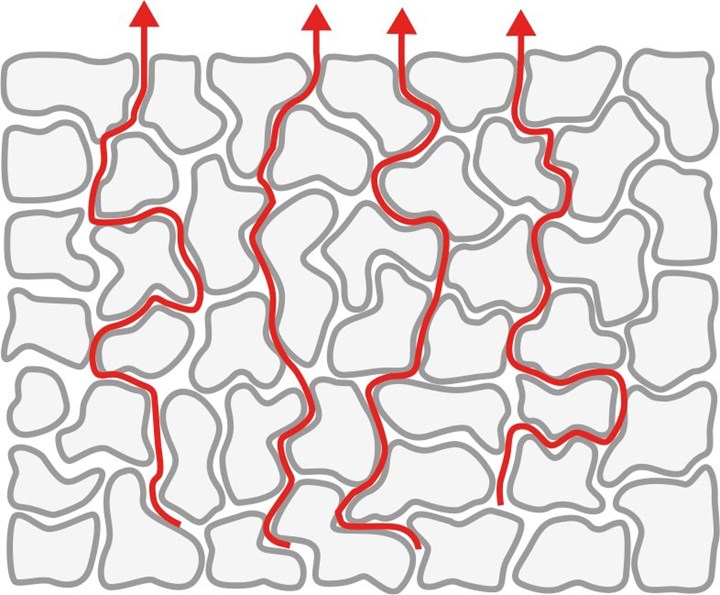
More pores provide more pathways for ions, which helps to increase energy density in a battery electrode.
Building Batteries with Photopolymerization
The process for these 3D printing batteries is similar to creating any other part with a photopolymerization process. The electrodes are 3D printed using a proprietary photopolylmer resin that serves as a binder for commercial electrode powder and conductive additives; the green printed parts are then cleaned and cured, followed by debinding and sintering to remove the polymer and leave only the active electrode material behind. Photocentric has actually developed a self-contained system for 3D printing batteries; parts travel from printing to washing and postprocessing automatically, avoiding the risks of contamination or damage to delicate electrodes.
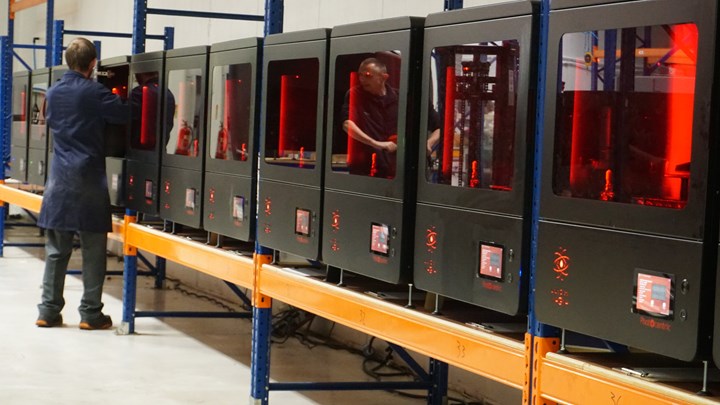
The 3D printed battery project likely to have an impact on electric vehicles also dovetails with Photocentric’s pursuit of sustainability in its own operations. Photocentric 3D printers rely on visible rather than UV light to cure photopolymer parts — a factor that means the machines use less energy to run. New sustainable materials from renewable sources and recycling efforts are also underway.
Thus far the company is working with electrode materials including lithium cobalt oxide (LCO) and lithium titanate (LTO); Karmel says the platform is material agnostic and could support other established battery chemistries as well. Photocentric’s aim now is to find industry partners that can provide input on the best chemistry and most useful geometries, and to demonstrate its 3D printed batteries in a vehicle.
Another approach to electrification: 3D printed solid-state batteries
“We can print batteries that work in the lab, but the question now is how will it perform in the device itself?” Karmel asks. If successful in use, 3D printed battery electrodes could lay the groundwork for lighter electric vehicles that offer better range, without changing the size of the battery pack; or for smaller battery packs in more convenient shapes and configurations that can provide the same range as today’s large arrays of heavy cells. Better performance could increase EV adoption and in turn, point toward more sustainable transportation.
Related Content
AM 101: Digital Light Synthesis (DLS)
Digital Light Synthesis (DLS) is the name for Carbon's resin-based 3D printing process. How it works and how it differs from stereolithography.
Read MoreAM 101: What Is Hot Isostatic Pressing (HIP)? (Includes Video)
Hot isostatic pressing has long been used for metal castings, but is now being applied as a valuable method for closing porosity in metal 3D printed parts.
Read More3D Printing with Plastic Pellets – What You Need to Know
A few 3D printers today are capable of working directly with resin pellets for feedstock. That brings extreme flexibility in material options, but also requires greater knowledge of how to best process any given resin. Here’s how FGF machine maker JuggerBot 3D addresses both the printing technology and the process know-how.
Read MoreUnderstanding HP's Metal Jet: Beyond Part Geometry, Now It's About Modularity, Automation and Scale
Since introducing its metal binder jetting platform at IMTS in 2018, HP has made significant strides to commercialize the technology as a serial production solution. We got an early preview of the just-announced Metal Jet S100.
Read MoreRead Next
New Electric Dirt Bike Is Designed for Molding, but Produced Through 3D Printing (Includes Video)
Cobra Moto’s new all-electric youth motocross bike could not wait for mold tooling. Parts have been designed so they can be molded eventually, but to get the bike to market, the production method now is additive manufacturing.
Read MoreMultimaterial 3D Printing Enables Solid State Batteries
By combining different 3D printing processes and materials in a single layer, Sakuu’s Kavian platform can produce batteries for electric vehicles and other applications with twice the energy density and greater safety than traditional lithium-ion solutions.
Read MoreWhy GM’s Electric Future Is Also an Additive Future
Production capacity isn’t the only reason that additive has been slow to make inroads into the automotive industry. There is a larger barrier to entry—one that General Motors and Autodesk are working to overcome.
Read More

.jpg;width=70;height=70;mode=crop)
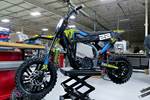

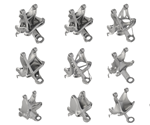





.png;maxWidth=300;quality=90)






